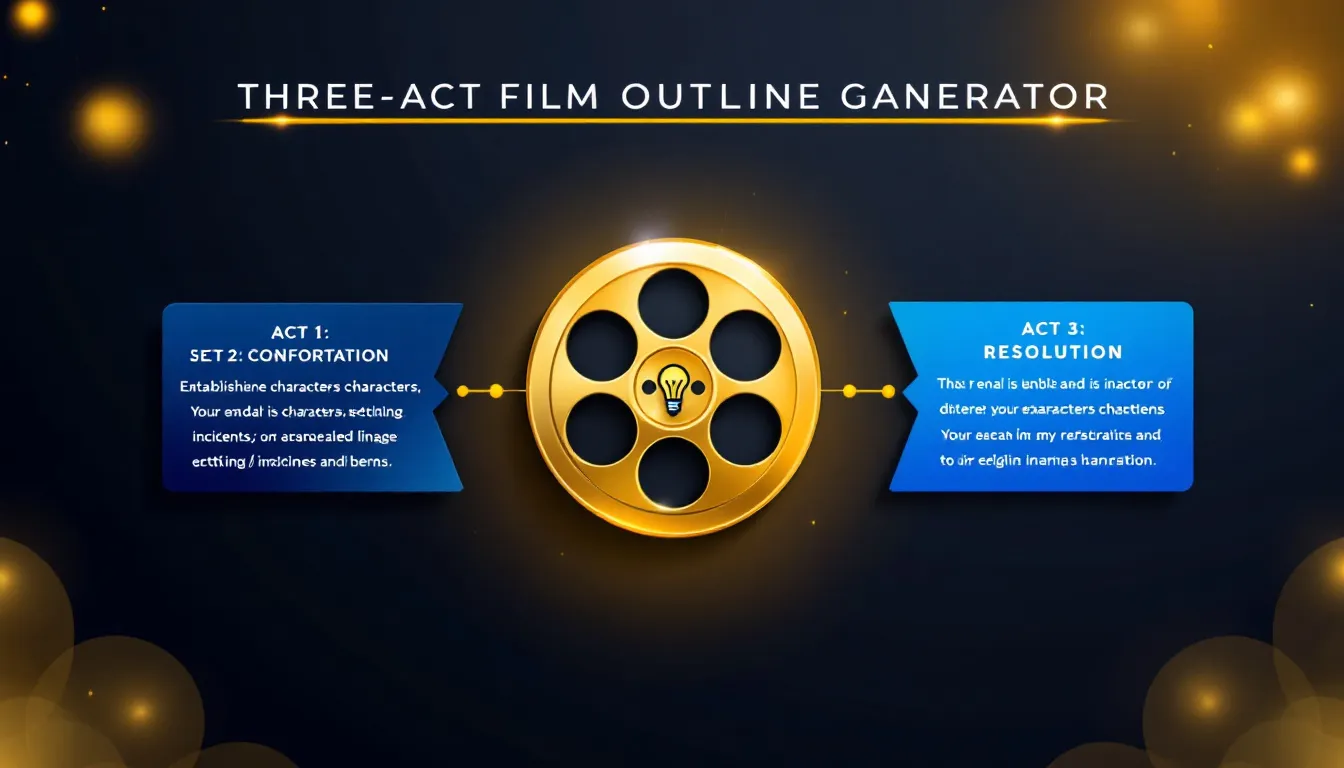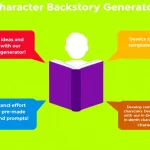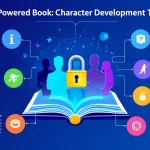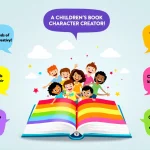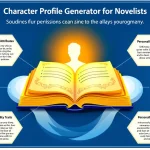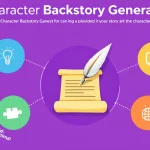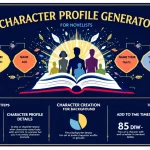Is this tool helpful?
How to Use the Film Outline Generator Effectively
The Film Outline Generator is a powerful tool designed to help filmmakers, screenwriters, and storytellers create a comprehensive three-act structure for their film projects. To use this tool effectively, follow these steps:
- Film Description: In the first field, provide a brief description of your film, including its genre and main theme. For example, “A coming-of-age drama about a young musician discovering her identity in a small town” or “A historical epic chronicling the rise and fall of an ancient empire.”
- Main Character: Enter the name and a brief description of your main character. This could be something like “Alex, a cynical detective with a hidden passion for poetry” or “Maya, an ambitious space explorer grappling with her fear of the unknown.”
- Central Conflict: Describe the central conflict or challenge that drives your story. For instance, “Alex must solve a series of cryptic murders while confronting his own past traumas” or “Maya leads a dangerous mission to an unexplored planet, risking everything to save her dying homeworld.”
- Setting (Time): Optionally, specify the time period in which your story is set. This could be “Present day,” “Medieval Europe,” or “The year 3000.”
- Setting (Place): Optionally, describe the location or environment where your story takes place. Examples include “A bustling cyberpunk metropolis” or “A remote island cut off from civilization.”
Once you’ve filled in the required fields, click the “Generate Film Outline” button. The tool will process your input and generate a comprehensive three-act structure for your film, complete with key plot points, character development, and thematic elements.
Introduction to the Film Outline Generator
The Film Outline Generator is an innovative tool designed to assist filmmakers, screenwriters, and storytellers in crafting compelling and well-structured narratives for their film projects. By leveraging the power of artificial intelligence and storytelling principles, this tool creates a detailed three-act structure based on the information provided by the user.
The purpose of this tool is to streamline the often challenging process of outlining a film’s narrative structure. It serves as a creative springboard, offering a solid foundation upon which filmmakers can build and refine their stories. By generating a comprehensive outline, the tool helps creators visualize the arc of their story, identify potential plot holes, and ensure a balanced and engaging narrative flow.
Key Benefits of the Film Outline Generator
- Time-saving: Quickly generates a structured outline, allowing creators to focus on developing their ideas rather than struggling with the initial framework.
- Creativity boost: Provides fresh perspectives and plot suggestions that can inspire new ideas or help overcome writer’s block.
- Structural integrity: Ensures that the story follows a classic three-act structure, maintaining narrative cohesion and pacing.
- Character development: Offers insights into character arcs and growth throughout the story.
- Thematic exploration: Helps identify and integrate key themes throughout the narrative.
- Flexibility: Generates outlines for various genres and story types, adaptable to different creative visions.
The Power of the Three-Act Structure in Filmmaking
The three-act structure is a fundamental principle in storytelling, particularly in film and television. It provides a tried-and-true framework that has been used in countless successful narratives across various mediums. Understanding and implementing this structure can significantly enhance the quality and impact of a film.
Act One: The Setup
The first act serves as the foundation of your story. It introduces the main characters, establishes the setting, and presents the central conflict or challenge that will drive the narrative forward. Key elements of Act One include:
- Exposition: Introducing the world of the story and its main characters.
- Inciting Incident: The event that sets the main story in motion.
- First Plot Point: The moment when the protagonist commits to addressing the central conflict.
Act Two: The Confrontation
The second act is often the longest and most complex part of the story. It delves deeper into the central conflict, presenting obstacles and challenges that the protagonist must overcome. Key elements of Act Two include:
- Rising Action: A series of events that increase tension and raise the stakes.
- Midpoint: A significant turning point that often changes the protagonist’s perspective or approach.
- Complications: Additional challenges that test the protagonist’s resolve and abilities.
- Second Plot Point: A major setback or revelation that propels the story into its final act.
Act Three: The Resolution
The third act brings the story to its climax and resolution. It’s where the central conflict reaches its peak and is ultimately resolved. Key elements of Act Three include:
- Climax: The highest point of tension in the story, often featuring a final confrontation or decisive moment.
- Resolution: The aftermath of the climax, showing how the events of the story have changed the characters and their world.
- Denouement: A final scene or sequence that ties up loose ends and provides closure.
How the Film Outline Generator Addresses Filmmakers’ Needs
The Film Outline Generator is designed to address several key challenges that filmmakers and screenwriters often face when developing their stories:
1. Overcoming Writer’s Block
Many creators struggle with getting started or moving past a creative block. The Film Outline Generator provides a structured starting point, offering plot suggestions and character development ideas that can spark inspiration and help writers overcome inertia.
2. Ensuring Narrative Cohesion
Maintaining a coherent and engaging narrative throughout a film can be challenging. The tool helps by creating a balanced three-act structure, ensuring that each part of the story serves a purpose and contributes to the overall narrative arc.
3. Character Development
Creating well-rounded, dynamic characters is crucial for engaging storytelling. The Film Outline Generator suggests character arcs and growth opportunities, helping writers craft more complex and relatable protagonists and supporting characters.
4. Thematic Integration
Identifying and weaving themes throughout a story can elevate its impact and resonance with audiences. The tool helps by suggesting thematic elements and opportunities to explore them throughout the narrative.
5. Pacing and Structure
Proper pacing is essential for maintaining audience engagement. The generated outline provides a framework for balanced pacing, ensuring that key plot points and character moments are appropriately spaced throughout the story.
Practical Applications and Examples
The Film Outline Generator can be applied to various types of film projects across different genres. Here are some examples of how it can be used:
Example 1: Sci-Fi Adventure
Let’s say a filmmaker wants to create a science fiction adventure about space exploration. They might input the following information:
- Film Description: A sci-fi adventure about humanity’s first interstellar mission and the ethical dilemmas they face upon discovering alien life.
- Main Character: Captain Zara Chen, a brilliant but ethically conflicted astrophysicist leading the mission.
- Central Conflict: The crew must decide whether to make contact with a newly discovered alien civilization, risking potential conflict or contamination.
- Setting (Time): 2150
- Setting (Place): A state-of-the-art spaceship and an alien planet with a breathable atmosphere.
The Film Outline Generator might produce an outline like this:
Act One:
- Introduce Captain Zara Chen and her crew as they prepare for humanity’s first interstellar mission.
- Show the advanced technology and the hopes and fears surrounding the mission.
- Inciting Incident: The crew discovers signs of intelligent life on their target planet.
- First Plot Point: Zara decides to lead a team to investigate the alien civilization, despite protests from some crew members.
Act Two:
- The team explores the alien planet, uncovering evidence of a highly advanced but reclusive civilization.
- Rising tensions among the crew as they debate the ethical implications of making contact.
- Midpoint: An accident leads to unintentional first contact with the aliens.
- The crew struggles to communicate and understand the aliens’ intentions.
- Second Plot Point: The aliens reveal a technology that could solve Earth’s energy crisis, but sharing it might irreversibly change both civilizations.
Act Three:
- Zara grapples with the decision to accept the aliens’ offer or maintain separation.
- Climax: A rogue crew member attempts to steal the alien technology, forcing Zara to intervene and make a final decision.
- Resolution: Zara chooses to respect the aliens’ privacy and leaves with a promise of future, carefully managed contact.
- The crew returns to Earth, forever changed by their experience.
Example 2: Historical Drama
For a historical drama, a filmmaker might input:
- Film Description: A historical drama about a forgotten female artist in Renaissance Italy fighting for recognition in a male-dominated world.
- Main Character: Isabella Rossi, a talented but struggling painter with a fierce determination to succeed.
- Central Conflict: Isabella must overcome societal barriers and personal doubts to prove her worth as an artist and secure a prestigious commission.
- Setting (Time): 16th century
- Setting (Place): Florence, Italy
The generated outline might look like this:
Act One:
- Introduce Isabella Rossi working as an apprentice in a renowned artist’s workshop.
- Show the challenges she faces as a woman in the art world, including skepticism and dismissal from male peers.
- Inciting Incident: A wealthy patron announces a competition for a major church commission.
- First Plot Point: Isabella decides to enter the competition, despite discouragement from her family and mentor.
Act Two:
- Isabella works tirelessly on her competition piece, facing numerous setbacks and obstacles.
- She forms an alliance with a sympathetic art dealer who believes in her talent.
- Midpoint: Isabella’s work gains attention, leading to both increased support and fiercer opposition.
- She struggles with self-doubt and the temptation to conform to more “acceptable” styles for women.
- Second Plot Point: Isabella’s main rival sabotages her work, nearly destroying her chance at the commission.
Act Three:
- Isabella rallies support from unexpected allies to complete a new piece for the competition.
- Climax: The competition judging, where Isabella must defend her work against harsh criticism and prejudice.
- Resolution: Isabella’s talent is recognized, and she secures the commission, paving the way for future female artists.
- Epilogue showing Isabella’s legacy and impact on the art world.
Frequently Asked Questions
1. Can the Film Outline Generator be used for short films?
Yes, the Film Outline Generator can be adapted for short films. While it generates a three-act structure typically used for feature-length films, you can easily condense and adapt the outline to fit a shorter format. Focus on the key elements of each act to create a concise yet compelling narrative structure for your short film.
2. How detailed is the generated outline?
The generated outline provides a comprehensive overview of your story’s structure, including key plot points, character development arcs, and thematic elements. While it doesn’t provide scene-by-scene breakdowns, it offers a solid foundation that you can further develop and expand upon in your screenwriting process.
3. Can I use the Film Outline Generator for different genres?
Absolutely! The Film Outline Generator is designed to work with various genres, from science fiction and fantasy to drama, comedy, and thriller. The tool adapts its suggestions based on the genre and theme information you provide, ensuring that the generated outline aligns with your specific genre conventions and storytelling needs.
4. How can I incorporate my own ideas into the generated outline?
The Film Outline Generator is meant to be a starting point and creative tool, not a rigid template. You can and should incorporate your own ideas, plot twists, and character moments into the generated outline. Use the outline as a framework to build upon, adding, removing, or modifying elements to align with your creative vision.
5. Is the Film Outline Generator suitable for experienced screenwriters?
Yes, the Film Outline Generator can be valuable for both novice and experienced screenwriters. For seasoned writers, it can serve as a brainstorming tool, offering fresh perspectives or helping to overcome writer’s block. It can also be useful for quickly generating alternative story structures or exploring different narrative approaches to a concept.
6. Can I save or export the generated outline?
Yes, once the outline is generated, you can copy it to your clipboard using the “Copy to Clipboard” button. From there, you can paste it into any text editor or writing software of your choice for further development and refinement.
7. How does the Film Outline Generator handle complex narratives or non-linear storytelling?
While the Film Outline Generator primarily focuses on creating a traditional three-act structure, you can adapt the generated outline for more complex or non-linear narratives. Use the outline as a foundation, then rearrange, expand, or interweave elements to create your desired narrative structure. The tool provides a starting point that you can creatively manipulate to suit your storytelling style.
8. Can I use the Film Outline Generator for TV series or other episodic content?
While the Film Outline Generator is primarily designed for feature films, you can adapt its output for TV series or episodic content. Use the generated outline as a basis for your series’ overall arc, then break it down into episode-specific plots. You may need to expand certain elements and add subplots to fill out a full season or series, but the tool can provide a solid starting point for your episodic structure.
9. How does the Film Outline Generator handle multiple protagonists or ensemble casts?
When using the Film Outline Generator for stories with multiple protagonists or ensemble casts, focus on the main conflict and overall narrative arc in your input. You can then adapt the generated outline to include multiple character arcs and subplots. Use the main structure as a backbone, and weave in additional character journeys and interactions to create a rich, multi-layered narrative.
10. Can the Film Outline Generator help with theme development?
Yes, the Film Outline Generator can assist with theme development. When you input your film’s description and central conflict, the tool will suggest thematic elements that align with your story. As you review the generated outline, look for opportunities to reinforce and explore these themes throughout the three-act structure. You can then expand on these thematic suggestions in your writing process to create a more cohesive and impactful narrative.
Important Disclaimer
The calculations, results, and content provided by our tools are not guaranteed to be accurate, complete, or reliable. Users are responsible for verifying and interpreting the results. Our content and tools may contain errors, biases, or inconsistencies. We reserve the right to save inputs and outputs from our tools for the purposes of error debugging, bias identification, and performance improvement. External companies providing AI models used in our tools may also save and process data in accordance with their own policies. By using our tools, you consent to this data collection and processing. We reserve the right to limit the usage of our tools based on current usability factors. By using our tools, you acknowledge that you have read, understood, and agreed to this disclaimer. You accept the inherent risks and limitations associated with the use of our tools and services.
